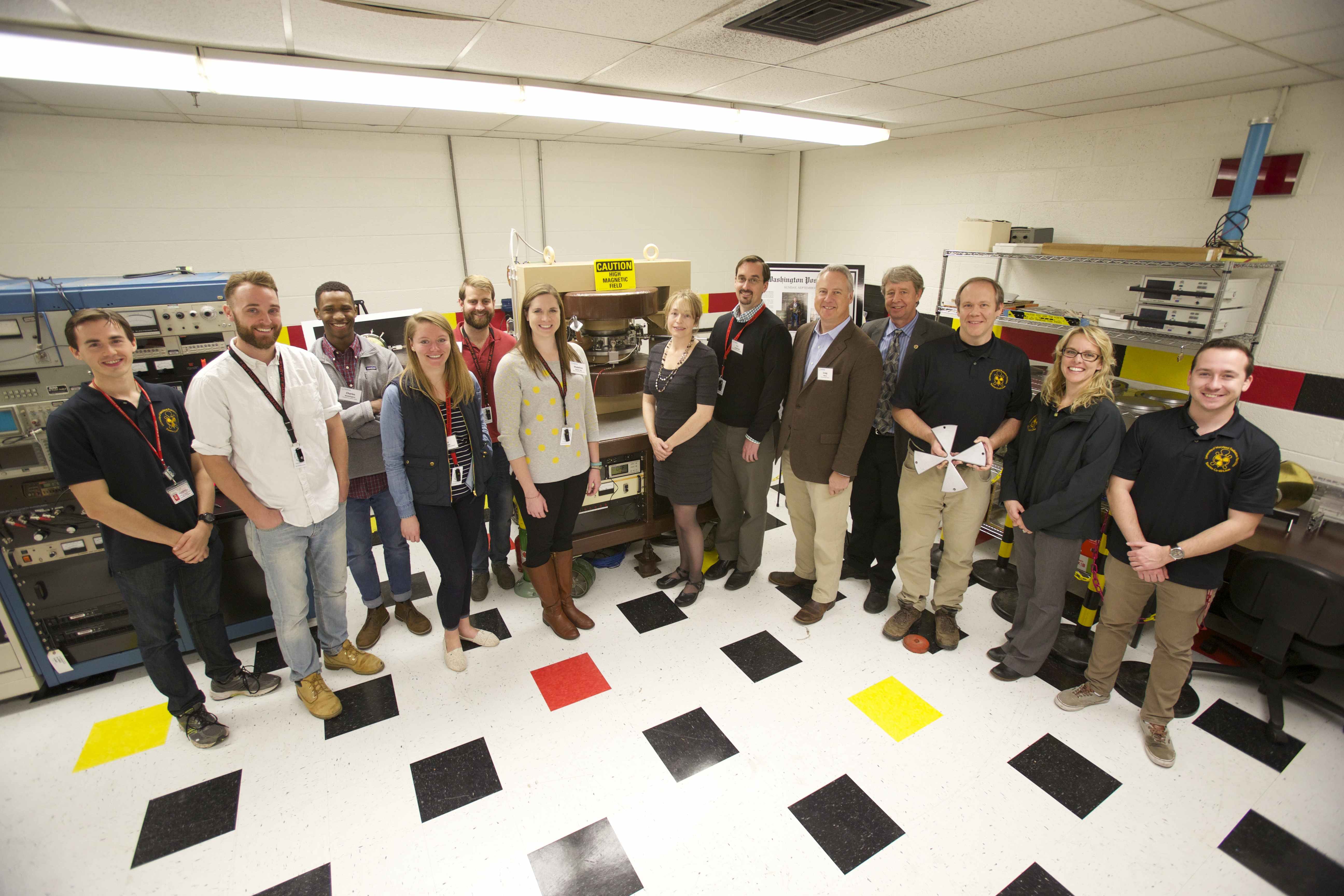News Story
Congressional Representatives Visit UMD Radiation Facilities

November 18th tour group beside a cyclotron, built by Dr. Koeth over a period of 17 years.
On November 18th, 2016, the University of Maryland Radiation Facilities, which houses the Maryland University Training Reactor (MUTR), hosted 10 visitors including 7 individuals representing various Congressmen/women and Senate Committees. Some visited out of personal interest, or sheer curiosity, while others routinely visit such sites around the United States with the end goal of improving current nuclear legislation.
UMD Radiation Facilities Director and Research Associate Professor Timothy Koeth, along with Faculty Assistant Amber Johnson and MSE graduate student, Travis Dietz, led the group on a tour of the facilities. MSE PhD Candidate, Mimi Hiebert, explained how she is currently using the reactor to study preservation techniques of various materials. Hiebert gave an intriguing synopsis of how neutron imaging can be utilized to detect water damage inside porous materials, such as limestone, which can then be used to improve preservation methods in antiquities.
Koeth discussed the numerous advantages of nuclear technology, specifically how it can be utilized in the treatment of cancer. “If treated with radiation, we can expect a 95% recovery rate in eye cancer,” he said. According to the American Cancer Society, an advantage of such therapy, as opposed to surgery, is the preservation of the eye structure - “this treatment cures about 9 out of 10 small tumors and can preserve vision in some patients, depending on what part of the eye the melanoma is in." Another advantage to nuclear energy is that it doesn't emit carbon dioxide, thus, its contribution to global warming is zero. It’s more reliable than solar or wind power, cheap to produce, and it’s efficient.
“Unfortunately,” said Koeth, “the UMD reactor is dealing with obsolescence.” Finding parts to maintain the reactor, built in 1974, becomes more difficult each year. Indeed, research training reactors are an endangered species – there are currently only 31 in the U.S. – and it doesn’t look like more will be built any time soon. For these reasons, the University of Maryland is committed to preserving, and maintaining, the Facilities.
The MUTR itself is completely approachable. In fact, the congressional visitors and this author were allowed to view the inside of the reactor. The core is encased inside concrete and 15 feet of water. At high power, one can clearly see the soft, blue glow of Cherenkov radiation – this so-called “sonic boom” for light is a result of charged particles passing through a medium faster than its speed of light.
The congressional visitors then stopped at the newest addition to the Radiation Facilities: an educational cyclotron, a two decade near-obsession for Koeth. It’s a sophisticated particle accelerator built by students, for students. In a setting unlike anything else in the world, Koeth’s cyclotron is a research grade machine that is dedicated to undergraduate instruction, teaching the science and technology of particle accelerators with an emphasis on hands-on learning. Practically every subsystem was designed and built by undergraduate students. This cyclotron, which was started by Koeth in his parents’ home, continued to evolve at Rutgers, his alma matter. Koeth’s cyclotron moved to UMD during the summer of 2016 and will be incorporated into his Capstone Design course, where the students are currently building the next, and bigger, student-built cyclotron: a 5 MeV proton accelerator that will be placed into research service once completed.
“Our cyclotrons give students a hands-on opportunity to operate an accelerator and directly observe many fundamentals of beam physics and encounter the frustrations and triumphs an accelerator physicist at Fermilab or CERN/LHC might, all in a classroom setting,” said Koeth.
For students who are interested, the facilities are always on the look-out for additional reactor operators and cyclotron students. UMD and UMGC students of any discipline can apply. The one criterion for acceptance into the program? “Enthusiasm,” says Koeth. Becoming a reactor operator isn’t too difficult – you needn’t be a physics whiz to manage it – however, time, discipline and math skills are required. A fantastic advantage to the one-year training program is that operators can become certified by the Nuclear Regulatory Commission (NRC), after passing a rigorous exam – a unique and beneficial addition to any resume.
For additional information, please visit the UMD Radiation Facilities website.
For additional background on the Koeth cyclotron, please read this Washington Post article, which was published on September 8, 2016.
Update: The MUTR received its renewal license in December of 2016. The license is valid for the next 20 years. For additional information, please read this related article.
Published December 19, 2016









